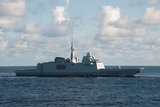Boeing establishes new C4ISR business division
The Boeing Company today announced it has created a new division to better align the company's Command, Control, Communications, Computers, Intelligence, Surveillance and Reconnaissance (C4ISR) capabilities. The new Electronic & Mission Systems (E&MS) division will operate within the Network and Space Systems business unit and include Argon ST, Digital Receiver Technology (DRT) and Boeing's tactical intelligence, surveillance and reconnaissance (ISR) programs.
"The synergy created by bringing Argon and DRT together with our tactical ISR programs will enable us to better serve our customers with integrated solutions and a strong team of experts," said Roger Krone, president of Network and Space Systems. "This new division enhances the depth of our C4ISR capabilities as we strive to offer our customers the best-value C4ISR solutions they need now and in the future."
The E&MS portfolio will include Ship's Signal Exploitation Equipment (SSEE) Increment F systems, serving the US Navy; the Enhanced Medium Altitude Reconnaissance Surveillance System (EMARSS), serving the US Army; and many of Argon's legacy Navy and Marine Corps programs. E&MS will focus on developing and implementing technically advanced, network-enabled C4ISR solutions, and also will serve as the primary division for solutions geared toward Navy customers.
E&MS will be led by Terry Collins, who previously served as vice president and general manager of Argon ST. Leadership of Argon ST will transfer to Vice President Joe Carlin, former head of Argon ST Information Dominance. DRT will continue to be led by Acie Vickers, its president and co-founder. Kerry Rowe, former Argon ST vice president of Operations, will lead Boeing ISR and Force Protection within E&MS.
Boeing acquired Argon ST in August 2010 and DRT in December 2008.
Source: Boeing
More from Digital Battlespace
-
![Babcock nears first customer for Nomad AI translation tool]()
Babcock nears first customer for Nomad AI translation tool
Nomad can provide militaries with real-time intelligence, saving critical time on the battlefield.
-
![AUSA 2025: Israel’s Asio Technologies to supply hundreds of improved Taurus tactical systems]()
AUSA 2025: Israel’s Asio Technologies to supply hundreds of improved Taurus tactical systems
Taurus operates alongside the Israel Defense Forces’ Orion system which supports mission management across tens of thousands of manoeuvring forces, from squad leaders to battalion commanders.
-
![AUSA 2025: Kopin pushes micro-LED plans as China moves faster]()
AUSA 2025: Kopin pushes micro-LED plans as China moves faster
The plan for the new displays follows fresh investment in Kopin’s European facilities by Theon and an order for head-up displays in fielded aircraft, with funding from the US Department of Defense.
-
![AUSA 2025: Persistent Systems to complete its largest order by year’s end]()
AUSA 2025: Persistent Systems to complete its largest order by year’s end
Persistent Systems received its largest ever single order for its MPU5 devices and other systems earlier this month and has already delivered the 50 units to the US Army’s 4th Infantry Division.
-
![Aselsan brings in dozens of companies and systems under the Steel Dome umbrella]()
Aselsan brings in dozens of companies and systems under the Steel Dome umbrella
Turkey has joined the family of countries attempting to establish a multilayered air defence system with government approval in August 2024 for the effort landed by Aselsan. Dubbed Steel Dome, the programme joins Israel’s Iron Dome, the US Golden Dome, India’s Mission Sudarshan Chakra and South Korea’s low-altitude missile defence system.
-
![DSEI 2025: MARSS unveils new agnostic multidomain C4 system]()
DSEI 2025: MARSS unveils new agnostic multidomain C4 system
MARSS’ NiDAR system has been deployed using sensors from static platforms to provide detection and protection for static sights, such as critical infrastructure, ports and military bases.




























